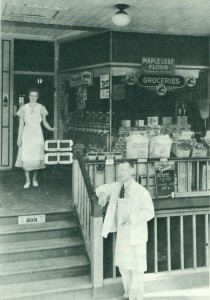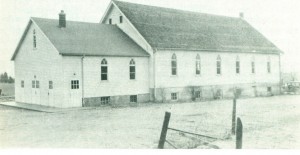With the Elder ordination of Rev. N. N. Driedger on May 21, 1933, and the concurrent ordination of Cornelius Tiessen to the church ministry and Henry B. Wiens to the deaconship, the affairs of the church became more solidified and stablized. Contributing to the stabilization was the completion of the church building, which was dedicated by Rev. David Toews on November 25,1934. Church services in Kingsville were now cancelled, and Leamington became the focal point of church life.

An unforgettable occurrence in the thirties was the economic depression that eventually became world wide after the resounding New York stock market crash in 1929. Some of its more common symptoms were unemployment, money shortage, and cessation of trade. The Mennonite Encyclopedia (270) reports that international trade decreased by two-thirds during the depression period.
The rippling effects of the depression were of course felt in Leamington as in other towns. A number of Mennonite farmers had purchased property at normal prices hoping to pay off their mortgage in the usual manner. When prices, however, continued to fall many were unable to retain their farms, and others were obliged to renegotiate prices and terms. Wages on the farm decreased to one dollar per day. Abram J. Dick (song leader), for instance, worked months on the Clifford farm near Ruthven in 1934 and received $300 plus a house to live in. Moreover his 14 year-old daughter was compelled to work beside her father for no wages. Employment opportunities sometimes came from tobacco factories and H. J. Heinz Company but again the wages were low. Katie Klassen (Mrs. P. P. Driedger) of Kingsville managed through piece work to raise her earnings to a height of $9.00 per week. Margaret Wiens (Mrs. Henry Brown) and Jesse and Greta Dick (Mrs. Jac. Unger and Mrs. Pet. Enns) earned $1.80 per day in the Heinz factory. Those who grew tomatoes under contract for the factory received 20-25 cents per bushel (60 pounds). Even that price helped many owners and share-croppers out of acute financial stress. Mennonites then did not work in offices or operate a business in town. A high school education was a rarity, research showing about seven Mennonite students receiving one.
Another aspect of the thirties was a rather large migration of Mennonites from the prairies to the Leamington community. Economic conditions were more aggravated there than in Essex County, wheat in the two top grades being 38 cents per bushel (Menn. Exodus 284). The Reesor settlement of Northern Ontario also felt the strain and stress of the times and gradually capitulated, resulting again in growth for the Leamington church. In the decade between 1934-1943 about 170 members from other Mennonite Leamington register. In the same period 211 persons were added through baptism. Pelee Islanders also moved to the mainland but they already had been members on the island. One must realize again that the founders of the church were those Mennonites that came directly from Russia to Waterloo to Essex County in 1924-25. The rapid growth thereafter was due to mobility from other Canadian areas.
The number of ministers increased in this period also. Added to the group already functioning were the following: Rev. Abram Rempel, 1932, from Pelee Island; Rev. Jacob C. Penner, 1935, from Grunthal, Manitoba; Rev. Jacob J. Epp, 1936, from Port Rowan, Ontario; Rev. Jacob N. Driedger, Sr., 1937, from Pelee Island.
Even though they were now nine in number, one never had the impression that the number had outgrown the need. Without any guidelines having been drafted in the matter, two ministers always served at Sunday morning services. Exceptions of course occurred. Ministers were usually sent once per month to both Harrow and Windsor.
With the growth of the congregation, it soon became necessary to think about expanding facilities. There was no convenient place, for instance, for the ministers to assemble prior to the service; no nursery accommodations, no cloak room, and no direct interior passage to the basement. Consequently, on November 26, 1936, a decision was reached to enlarge the front of the church with a 24 x 32 addition in a style resembling that of the main building. No one seemed to worry about architectural drawings – inexpensive and practical were the watchwords. When at a later date Rev. Jacob H. Janzen saw the completed addition, he remarked in his amusing way, “It looks as though a young building has sprouted from the old.”

A sum of $750.00 was allocated for the addition, with Rev. W. Schellenberg as chief carpenter receiving 25 cents per hour. Others working on the project were to do so without remuneration. Jacob Barkowsky, Sen. and Abram J. Dick (song leader) were elected to serve in an advisory capacity. The addition was to contain a nursery, a ministers’ study, and a vestibule, each with wide doors facing the main auditorium so that the added rooms could also be utilized as seating areas should the main aduitorium become overcrowded. Wedding parties, too, were to assemble in the ministers’ study prior to the ceremony. One might digress at this point momentarily and point out that wedding couples on their way to the chancel were obliged to make several detours owing to the gas heaters in the aisle. Today’s sophistication would surely never permit such an awkward arrangement. When after 10 years the stoves were removed and a coarsely woven runner wasplaced in the aisle, the bride discovered that her thin veil and the rough fibres were incompatible and so for weddings the runner had to be removed.
When the addition was completed, everyone appeared satisfied with the structure except for one item – the cost. The cost at completion had risen to $2276.00, a tremendous increase from theoriginal allocation. The main building had been built for $3100.00 only four years earlier. One might ask what had caused the discrepancy. In the first place, the estimate had been quite inaccurate, two washrooms not in the original plans had been subsequently added, material superior to that of the old building had been used, and finally the chief carpenter had been none too conscious of cost. When accountability time arrived at a membership meeting, his intention had been to make no attempt to justify the increased costs but to remain silent. The situation never became tense, however, since the membership was satisfied with the building. Rev. Schellenberg on his part had demonstrated courage and foresight in determining to build well and adequately. To meet the cost, a one dollar per member levy had already been made previously; donations were now received, and on February 5,1939, the addition was paid for.
The first person to maintain the building was Henry Barkowsky, who served two years. He was then 65 years of age. He was followed by his brother Jacob, who maintained the building almost continuously for 11 years. At the beginning of his term he lived on Elliott Street and commuted to and from church on his bicycle. On one of these occasions he was struck down by a car, and thereafter convalesced for a time in the hospital. Eventually he moved to 85 Wigle, and since no development had taken place in the area he could observe the church from his window. In 1936 he received 100 dollars for his efforts; in 1937 his wage was increased to 12 dollars per month, and in 1943 it was again raised to 30 dollars per month. Following Jacob Barkowsky in the maintenance position were the Jacob Loewens, Abe Dicks, Gerhard Warkentin, and Johann Warkentin. (The latter two have now passed away.) On June 6, 1948, Peter A. Hamm undertook the responsiblities and continued in that capacity until the end of 1956. Since that time the Ernie Tiessens have cared for and maintained the building, a task that is for the most part inconspicuous but nonetheless necessary.
During the years 1933-1935 Rev. Cornelius Tiessen had conducted weekly Bible studies during the winter for young people. These studies continued in enriched form by Mr. Henry Janzen of Waterloo during 1936-1938, but then suffered a seven-year lapse until Rev. Jacob A. Dyck, the eventual Elder of the Niagara Church, reconvened them by instructing 12 students in a winter day school. This day school ultimately blossomed into what is now the United Mennonite Educational Institute.
Bible classes were also organized for adults, in homes at first but later on a regular basis in the church. Unfortunately, participation was always less than enthusiastic.
Membership meetings and church council sessions were often caIled to order after Sunday morning services. Many times meetings were summoned in haste and on an informal basis so that in numerous instances keeping minutes was dispensed with. The annual meeting, however, was given special consideration in that a definite time was aIlotted to it and minutes have been faithfuIly recorded since 1934.
Burials were also very much a part of church life. Since burial plots were selected at first near the dweIling places of survivors, one can discover Mennonite graves in Wheatley, Olinda, KingsviIle, Harrow, Windsor, Pelee Island, etc. In 1931, because of negotiations by Rev. J. D. Janzen a parcel of land (eight plots) was purchased from the Ruthven cemetery (corner of Highway 3 and Townline) for $2.50 per plot. Rev. Janzen’s father-in-law, David Unrau, deacon, was the first Mennonite to be interred there in June, 1931. Further plots were added in subsequent years until offers to purchase were finaIly turned down. In the meantime, Evergreen Memorial Park Cemetery became available, and in 1949 many Mennonite families purchased plots at 60 doIlars for six plots. Gerhard Warkentin was the first Mennonite to be interred here in June, 1949.
A sensitive visitor to either the 110 Mennonite graves of the older cemetery or to the 215 graves (as of July 6, 1971) of Evergreen Memorial, wiIl meditate on the human condition – transient, mutable, and will then look forward to ponder the eternal.
